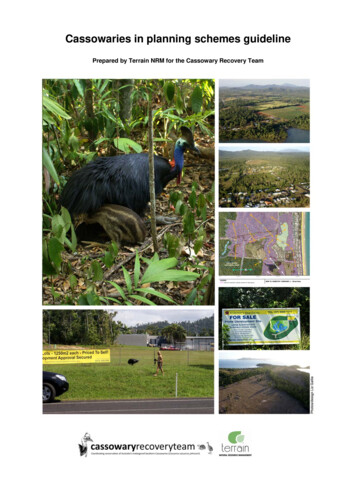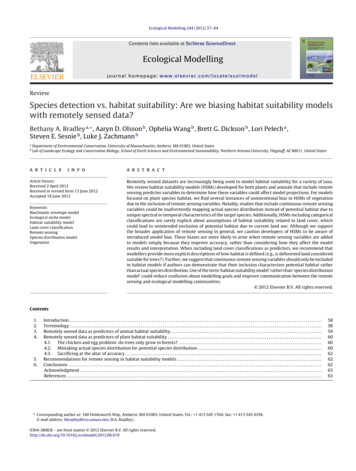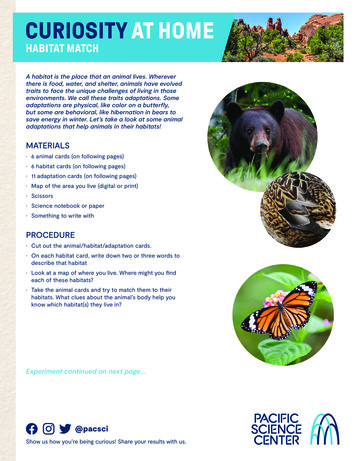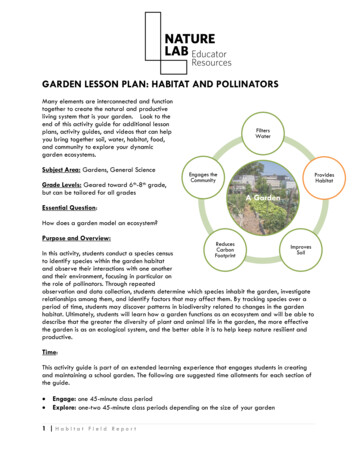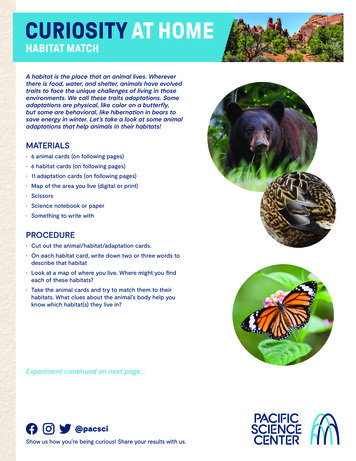
Transcription
CURIOSITY AT HOMEHABITAT MATCHA habitat is the place that an animal lives. Whereverthere is food, water, and shelter, animals have evolvedtraits to face the unique challenges of living in thoseenvironments. We call these traits adaptations. Someadaptations are physical, like color on a butterfly,but some are behavioral, like hibernation in bears tosave energy in winter. Let’s take a look at some animaladaptations that help animals in their habitats!MATERIALS 6 animal cards (on following pages) 6 habitat cards (on following pages) 11 adaptation cards (on following pages) Map of the area you live (digital or print) Scissors Science notebook or paper Something to write withPROCEDURE Cut out the animal/habitat/adaptation cards. On each habitat card, write down two or three words todescribe that habitat Look at a map of where you live. Where might you findeach of these habitats? Take the animal cards and try to match them to theirhabitats. What clues about the animal’s body help youknow which habitat(s) they live in?Experiment continued on next page.@pacsciShow us how you’re being curious! Share your results with us.
CURIOSITY AT HOMEHABITAT MATCHEXPLORE MOREChoose another habitat and make a list in your science notebook of animals that livethere. Name some adaptations that each animal has to help it live in that habitat.DID YOU KNOW?This activity uses examples of adaptations for heat, snow, cold and water. Large earsare an important way of getting rid of excess body heat, and are found on animals likerabbits and elephants. Large feet spread an animal’s weight around so it can walk ontop of the snow without sinking, and furry feet can help an animal keep from losing toomuch body heat to the snow. Webbed feet can help an animal to swim more easily andoily, waterproof hair can keep that animal warm and dry while they swim.@pacsciShow us how you’re being curious! Share your results with us.
CURIOSITY AT HOMEHABITAT MATCHANIMAL CARDSCut each one out.JackrabbitSnowshoe HareWA Ground SquirrelRiver OtterBlack BearBeaver@pacsciShow us how you’re being curious! Share your results with us.
CURIOSITY AT HOMEHABITAT MATCHHABITAT CARDSCut each one out.DESERT:RIVER/CREEK:MOUNTAIN:ALL 3 HABITATS:@pacsciShow us how you’re being curious! Share your results with us.
CURIOSITY AT HOMEHABITAT MATCHADAPTATION CARDSCut each one out.Estivation(similar to hibernation)NocturnalFurry feetWater-resistant hairsHibernationWater-resistant hairsLarge earsWebbed feetLarge feetWebbed feetLives underground@pacsciShow us how you’re being curious! Share your results with us.
CURIOSITY AT HOMEHABITAT MATCHK–2 GRADE EXPLORATIONHere are some questions you can explore together. Compare the fur of the animals in different habitats. What do younotice about their fur color? Which habitat has animals with thefluffiest fur? Why might that be? Which animals in this activity live in the same habitat? What do theseanimals have in common? Many of the animals in this activity have fur colors that help themhide in their habitat. This is called camouflage. Try putting the animalcards in a new habitat. Would they be able to hide there?@pacsciShow us how you’re being curious! Share your results with us.
CURIOSITY AT HOMEHABITAT MATCH3 –5 GRADE EXPLORATIONExplore the following questions and write your observations in your sciencenotebook. Compare the two types of rabbits on the list. What about them is the same? Whatabout them is different? How could those differences help each rabbit in theirhabitat? Some of the animals we looked at have special adaptations to their feet to helpthem move around their habitat. Can you think of any other types of animals withspecial feet? Camouflage is when an animal uses color or patterns to hide in their habitat.Which animals on this list use camouflage? What other animals can you think ofthat use camouflage in their habitats?@pacsciShow us how you’re being curious! Share your results with us.
CURIOSITY AT HOMEHABITAT MATCH6–8 GRADE EXPLORATIONExplore the following questions and write your observations in your sciencenotebook. One of the animals in this activity lives in many habitats. Can you think of otheranimals that live in many habitats? Make a list of some of these animals and anadaptation each one has that helps it survive in many different types of places. Choose an animal in this activity and imagine how it might have to adapt to live ina different habitat. What might this new animal might look like? Adaptations are passed down from generation to generation and not only helpanimals survive, but also help them to successfully reproduce, and thus pass onthose traits. Choose one of the animals here, or another animal. Make a list ordraw a picture of some of the animal’s adaptations (physical or behavioral) thathelp them to successfully breed and care for their young.@pacsciShow us how you’re being curious! Share your results with us.
environments. We call these traits adaptations. Some adaptations are physical, like color on a butterfly, but some are behavioral, like hibernation in bears to save energy in winter. Let's take a look at some animal adaptations that help animals in their habitats! MATERIALS 6 animal cards (on following pages)

